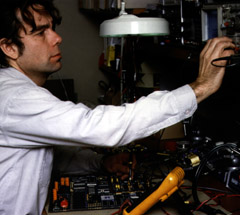 |
Earthquakes
happen about five times a day in British Columbia. Many significant
quakes occur in unpopulated areas, where there is no one around
to feel them. Smaller ones can be noticed if they occur in more
densely populated areas. The earth is always moving, and that movement
is continuously recorded at instrument sites monitored by the Pacific
Geosciences Centre near Victoria. Earthquake sensors called seismometers
are installed at isolated locations along the coast. They can detect
vibrations from earthquakes that happen in other parts of the world,
as well as ones centered nearby. These sensors receive signals from
the Global Positioning System (GPS), and are so sensitive that they
can detect trucks rumbling down the highway a kilometre away. But
these kinds of vibrations are recognized and filtered out electronically
during analysis. Each seismometer is connected to a geophysical-data
digitizer, a device which converts the vibrations recorded by the
seismometer into a radio signal that is sent to the Pacific Geosciences
Centre.
There, the data is analyzed by Tim and other
men and women working in earthquake seismology. They can't predict
earthquakes, but they have theories and can estimate the probability
of a future big earthquake on the West Coast. "Mostly earthquakes
give us great excitement," says Tim. Most people get worried if
they feel an earthquake, but Tim is different. He gets downright
enthusiastic. Few earthquakes in British Columbia cause any damage
or injury. There's so much to be learned from each earthquake
- what happened, why, and the effects on the area. After things
calm down, they analyze the data from their sites.
In winter, Tim analyzes data and builds data
digitizers from scratch. He works with an engineer who sketches
out the basic design. Tim then adds meat to the bones by designing
the circuit board on computer, and putting the prototype together
from individual electronic components. Once he has a working prototype
he contracts out the assembly of the required units to a local
electronics company, and then tests each one when it is delivered.
A data digitizer fits inside a weatherproof box that is about
one foot square in size.
Tim contracts out the work to construct new sites
based on his drawings to local communications companies. This
building work involves pouring concrete for the seismometer vaults,
setting up antenna towers, and installing the basic telecommunications
equipment. Tim then goes to each new site for a day, installs
the more delicate equipment, and adds that site to the list of
30 sites he visits and inspects each summer on Vancouver Island,
the Queen Charlottes, and the lower mainland. The antennas and
solar panels are sometimes damaged by lightning, ice, and snow.
These inspections can involve week-long trips to a number of sites,
with Tim operating a four-wheel drive truck. Sometimes he hires
a helicopter to reach remote mountain top sites, but more often
he hikes in through the bush for a kilometre or more. He carries
a cell phone or a two-way radio in the field.
|
 |


